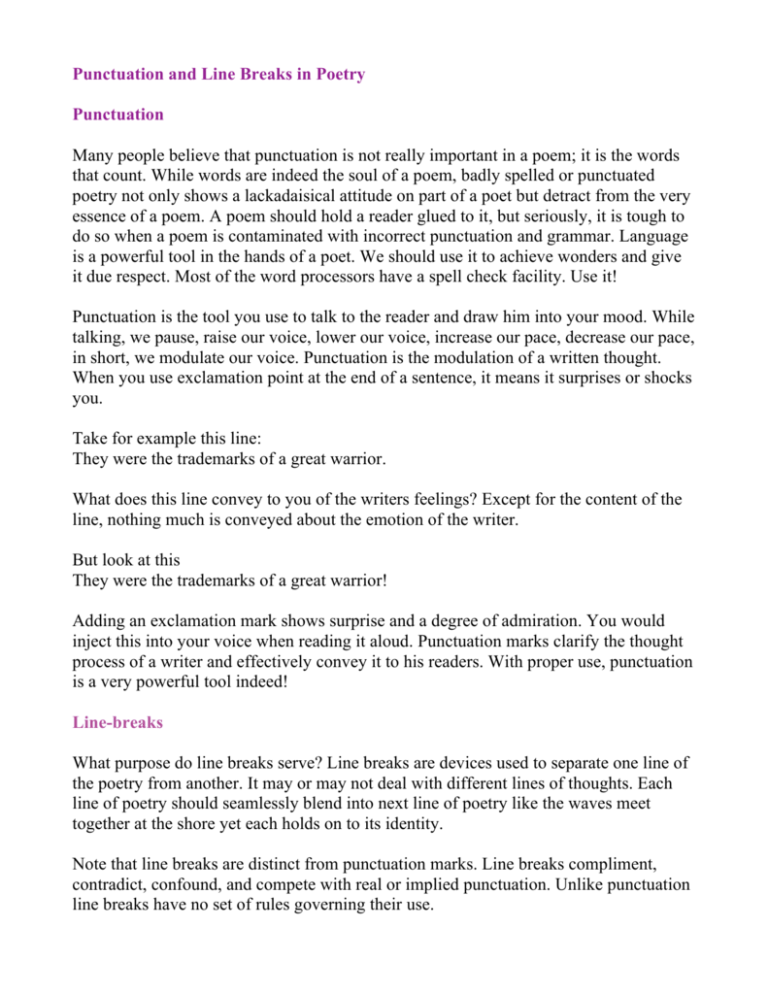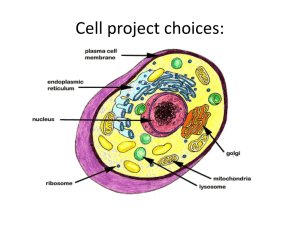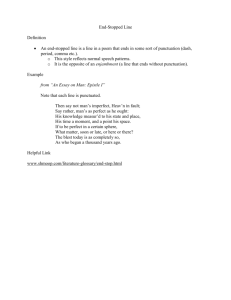Punctuation and Line Breaks
advertisement

Punctuation and Line Breaks in Poetry Punctuation Many people believe that punctuation is not really important in a poem; it is the words that count. While words are indeed the soul of a poem, badly spelled or punctuated poetry not only shows a lackadaisical attitude on part of a poet but detract from the very essence of a poem. A poem should hold a reader glued to it, but seriously, it is tough to do so when a poem is contaminated with incorrect punctuation and grammar. Language is a powerful tool in the hands of a poet. We should use it to achieve wonders and give it due respect. Most of the word processors have a spell check facility. Use it! Punctuation is the tool you use to talk to the reader and draw him into your mood. While talking, we pause, raise our voice, lower our voice, increase our pace, decrease our pace, in short, we modulate our voice. Punctuation is the modulation of a written thought. When you use exclamation point at the end of a sentence, it means it surprises or shocks you. Take for example this line: They were the trademarks of a great warrior. What does this line convey to you of the writers feelings? Except for the content of the line, nothing much is conveyed about the emotion of the writer. But look at this They were the trademarks of a great warrior! Adding an exclamation mark shows surprise and a degree of admiration. You would inject this into your voice when reading it aloud. Punctuation marks clarify the thought process of a writer and effectively convey it to his readers. With proper use, punctuation is a very powerful tool indeed! Line-breaks What purpose do line breaks serve? Line breaks are devices used to separate one line of the poetry from another. It may or may not deal with different lines of thoughts. Each line of poetry should seamlessly blend into next line of poetry like the waves meet together at the shore yet each holds on to its identity. Note that line breaks are distinct from punctuation marks. Line breaks compliment, contradict, confound, and compete with real or implied punctuation. Unlike punctuation line breaks have no set of rules governing their use. Line breaks can be loosely classified into end stopped line, enjambments and caesuras. End-stopped lines End-stopped lines put a clear rhythmic break at the end of each line, often reinforced by a comma or period. Look at these lines from William Wordsworth’s poem "She Dwelt Among the Untrodden Ways": She lived unknown, and few could know When Lucy ceased to be; But she is in her grave, and, oh, The difference to me! Each line of the poem is an individual sentence or fragment of thought and is independent of rest of the poem to make a meaning. Enjambments Enjambments conversely run into each other and make meaning in conjunction with each other rather than independent units like end stopped lines. Consider the opening lines of Milton’s “Paradise Lost”: Of man's first disobedience, and the fruit Of that that forbidden tree Enjambments are also called run on lines as they run into each other. "Run on lines" run forward in sense and punctuation into the next line, like the opening line of Milton's "Paradise Lost:" shown above. Enjambment is the breaking of a linguistic unit (phrase or sentence) by the end of line between two verses. It is in contrast with end stopping, where each linguistic unit corresponds with the line length. Consider Shakespeare Sonnet number 11: As fast as thou shalt wane, so fast thou grow'st In one of thine, from that which thou departest; And that fresh blood which youngly thou bestow'st, Thou mayst call thine when thou from youth convertest. Herein lives wisdom, beauty, and increase; Without this folly, age, and cold decay: If all were minded so, the times should cease And threescore year would make the world away. Let those whom nature hath not made for store, Harsh, featureless, and rude, barrenly perish: Look whom she best endow'd, she gave the more; Which bounteous gift thou shouldst in bounty cherish: She carv'd thee for her seal, and meant thereby, Thou shouldst print more, not let that copy die. This sonnet uses heavy enjambment. Usually an enjambment is marked by the use of a comma, colon or semi-colon. As you can see, Lines 1, 2, 3, 4 are all enjambed, while line 4 is an end- stopped line. Enjambments can be cleverly used in a poem to make it more interesting and even create a feeling of suspense that prompts the user to go and read the next line to see what happens. It also stops a poem from being just a sequence of related sentences. Meaning flows from line to line, and the reader's eye is pulled forward. Enjambment creates a feeling of acceleration, as the reader is forced to continue reading after the line has ended. Enjambments are used to smoothen the edges of a poem and make it flow more fluidly. Also when a line of thought is too large to fit into a single line, enjambment is used to split it into more than one line. Caesuras Caesura is Latin word for cut. Caesura is a natural pause in a verse or a sentence, usually reinforced by punctuation. When it is accompanied by a punctuation mark it is called a strong caesura. If there is no punctuation, it is a weak caesura. More than one caesura can occur in the same line or verse. Strong: Alas! For the days and months wasted Weak: Alas if I but known the trials of life a little earlier. When you consider line breaks as you write your own poetry, remember that there is no one right or wrong way to turn the lines in a poem. Some ways will sound better than others, though. Some ways will make the poem read more smoothly. Others will seem awkward or confuse the reader. Short lines may make a poem seem to speed up, while longer lines may slow it down a bit. If one line is much shorter than the others, that will draw attention to that line. Short lines can sometimes make a poem sound "choppy," so watch out for that. Poems usually read more smoothly if all the lines are similar in length, but that can grow predictable and dull. Varying the length of the lines can create interest, both visually and in the way the poem reads.






